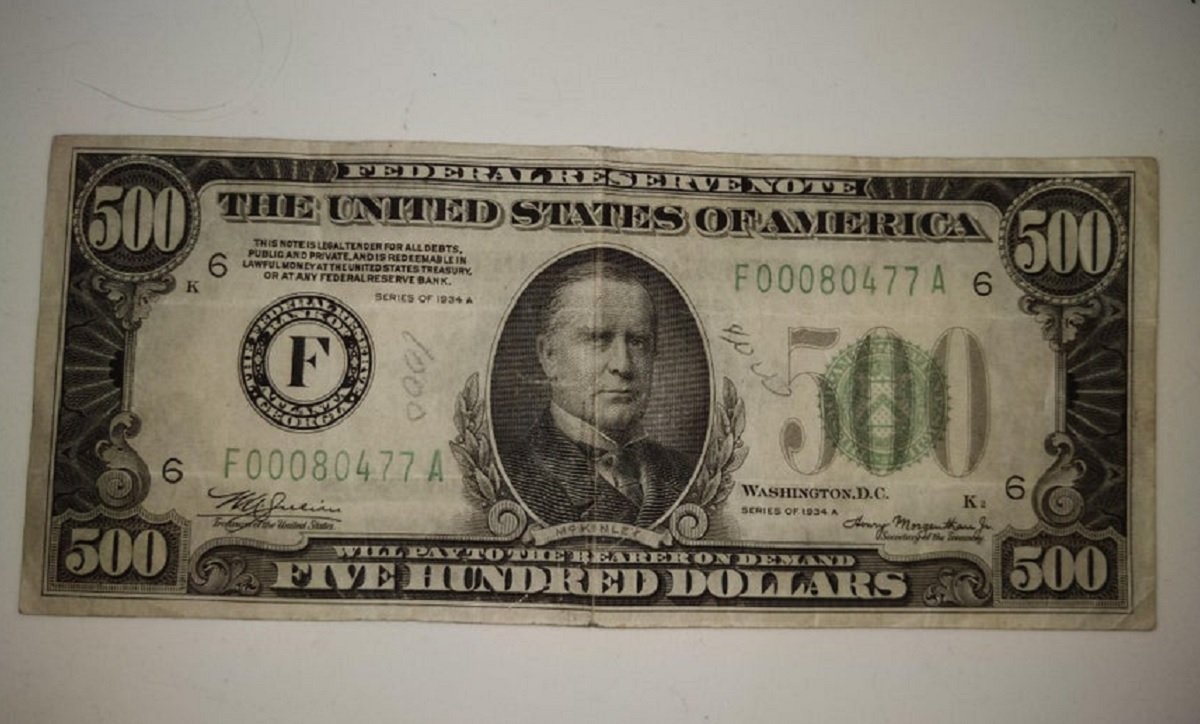Money is something we're all familiar with, but whether you're a millionaire or trying to make ends meet, you've probably never seen a $500 note before.
George Washington is likely the president you're most familiar with, as the founding father graces the $1 bill.
Abraham Lincoln, Alexander Hamilton, and Andrew Jackson could be old friends, while Ulysses S. Grant is more like an acquaintance.
Many more prominent figures feature on paper money, yet they rarely get recognition owing to how rare the bills are.
One of them is the $500 note, with two designs, one featuring John Marshall, and the other William McKinley.
While both are rare, the former seems more elusive owing to the fact it was printed in 1918, while the latter hails from the 1928 and 1934 series, according to the Bureau of Engraving and Printing of the U.S. Department of the Treasury.
One Redditor stumbled across what they claimed was a genuine bill, featuring McKinley, and shared a snap of the money to the site's Mildly Interesting forum.
"A real and very rare $500 bill," Supershayan, aka Shane Snider, wrote on Tuesday, with their post amassing more than 50,000 upvotes.
Snider, from California, told Newsweek: "It's my dad's. He found it in my grandfather's office. My grandfather has dementia so they've been helping organize some of his stuff. There's no plan for it but people have offered to buy it.
"Our highest bid was $2k. Some people on reddit said that it was not worth anything near that but some others said it can be worth closer to $20k."
The large note is still legal tender in America, but few are in regular circulation as most are stashed in private collections.

And although they're only worth $500, their actual value is much higher owing to their scarcity, with the bills sold online for more than double their face value.
Excelius wrote: "Governments around the world have been cracking down on large denomination bills. They're often used for illicit purposes, from tax evasion to drug trafficking.
"The $500 bill was discontinued in 1969, the €500 note ceased being printed in 2019.
"Currently the $100 bill is the largest currently printed denomination in the US, however there have been proposals to eliminate it and perhaps even the $50 bill."
While Fit-Strength6533 wrote: "In my world $50 bills are very rare."
BreezyGoose revealed: "My dad has one in a similar condition to OP and he paid I think $600 for his."
While Ok_Day_675 reckoned: "If inflation keeps up the mint is gonna have to bust these back out."
"I just turned 39 in this past October and I can remember seeing these a few times when I was kid. Been probably 30 years since I've seen one," Ghandi253 added.
Explaining why they're so rare, the Bureau of Engraving and Printing revealed the bills ceased being printed in 1969.
They said: "United States currency denominations above $100 are not available from the Department of the Treasury, the Federal Reserve System, or the Bureau of Engraving and Printing.
"On July 14, 1969, the Department of the Treasury and the Federal Reserve System announced that currency notes in denominations of $500, $1,000, $5,000, and $10,000 would be discontinued immediately due to lack of use. Although they were issued until 1969, they were last printed in 1945."
The larger notes in circulation sees Alexander Hamilton grace the $1,000 bill, from the 1918 series, while Grover Cleveland is on the front of the 1928 edition.
James Madison adorns the $5,000 note, while Salmon P. Chase adorns the highest legal tender, with series printed in 1918, 1928 and 1934.
A $100,000 gold-certificated bill was also produced in 1934, featuring president Woodrow Wilson.
This was used only for official transactions between Federal Reserve banks, before electronic banking, and private collectors cannot legally own one.
UPDATE 12/22/21, 9:52 a.m. ET: This article was updated with comment and photos from Snider.
Uncommon Knowledge
Newsweek is committed to challenging conventional wisdom and finding connections in the search for common ground.
Newsweek is committed to challenging conventional wisdom and finding connections in the search for common ground.
About the writer
Rebecca Flood is Newsweek's Audience Editor (Trends) and joined in 2021 as a senior reporter.
Rebecca specializes in lifestyle and viral ... Read more
To read how Newsweek uses AI as a newsroom tool, Click here.






